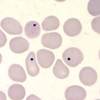Hematology #1 Flashcards
All blood tubes have a type of anticoagulant in them.
False
A clean stick is only necessary for routine blood work before anesthesia.
False - a clean stick should be sought after at all times.
WBCs are generally larger than RBCs
True
Platelets are considered a piece of another cell with multiple nuclei
False
WBCs mainly do their job in the blood stream
False
A LTT blood tube is used for a CBC test
True
Blood gases would use a GTT
True
Chemistries and Serology would use a SST for blood collection?
True
Coagulation tests would use a BTT tube
True
What % of plasma is water?
93%
What is the largest of the WBCs?
Neutrophil
Production of blood cells within the bone marrow is called
Hematopoisis
What is the term for a decrease in WBCs
leukopenia
Term for an increase in WBCs
Leukocytosis
What type of WBC would be increased in an animal with allergies?
Eosinophils










